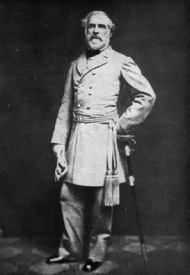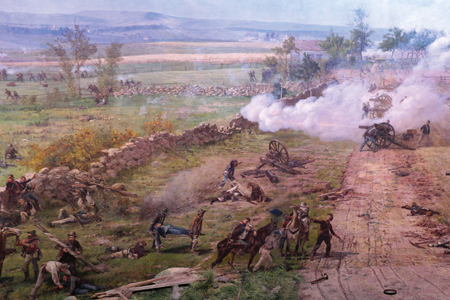Hello, history buffs! Today we are going to conclude the final chapter of the battle of Gettysburg.

Gen.Meade
After their attempts to encircle the Federal army had failed, the Confederates fell back to their positions on Seminary Ridge. Robert E. Lee knew the that, unless he won quickly, he would have to fall back into Virginia. The Federal line had been battered and bruised but not broken, yet George Meade, the Federal commander, feared a massive defeat still. The Federal 1st, 2nd, 3rd, 5th, 11th and 12th corps had all been heavily engaged, and the Union forces had lost many good commanders and men (most notably the 1st Minnesota Regiment, which had charged into the fight with 262 men and returned with just 47).

Gen. Lee
Lee saw a weakness in the Union lines. The Union center was battered and without reinforcement. If he moved fast, Lee could cave in the Union center and destroy the Union armies–a tactic Napoleon had used. But Lee’s generals were cautious. Their troops would have to march over open ground while Union guns pounded them. Lee knew this, but he knew if his commanders coordinated well, they could break through and win. Lee wanted to use the same strategy he had used the previous day. Robert Rodes and his division would attack the Federal position on Cemetery Ridge, while Jubal Early and Edward Johnston’s division would attack the Federal forces on Culp’s Hill. James Longstreet and his corps would assault the Union center.

Stuart’s Brigade renewing the attack on Culp’s Hill
However, the attack on Culp’s Hill was badly coordinated, and the Federal forces counter-attacked, driving the Confederates back. Lee then decided to attack the Federal center. He had Longstreet’s and A.P Hill’s corps to back him up. George Pickett’s fresh division–part of Longstreet’s corp–had arrived. Lee planned a massive assault on the Federal forces, during which 150 Confederate cannons would be used. At 1pm, the Confederates opened fire on the Union center, commanded by Second Corps Commander Winfield Scott Hancock. The artillery barrage could be heard in all the way in Harrisburg, Pennsylvania, 38 miles to the north. The barrage had little effect on the Union artillery, but a massive psychological effect on the Union troops. Many panicked and ran. Others stood close to the cannons. Many Federal commanders 0rdered their guns not to respond. Lee knew that the bombardment had little effect, but he was ready for the attack. The Confederates assaulted the Federal center under blazing heat. The Federal guns responded by unleashing devastating fire from their guns.

Federals firing across the stone wall at Confederate troops
The three divisions (two part of A.P Hill’s corps) assaulted the Federal position, but, again due to poor coordination, their attacks met with failure. Three brigades in Pickett’s corps were slaughtered. Gen. Lewis Armistead, commanding the largest brigade in Pickett’s division, rallied the remains of the corps and led them toward the Federal line. At close range, the Confederates unleashed devastating volleys on the Federals. The Federal brigade facing General Armistead, comprised of men from Philadelphia, fell back in terror, and many men ran for their lives. Alexander Webb, the Union commander, desperately tried to form his brigade for a counter-attack. Armistead and 200 others rushed toward the stone wall at the Federal center as Union troops ran for their lives. The Confederates formed a foothold, but soon wave upon wave of Federal troops counter-attacked. The first waves of Federal troops were driven back, but, gradually, the Federals received reinforcements, driving the Confederates back with serious losses. Armistead was mortally wounded in the fight. “Pickett’s Charge,” as it was later called, ended the battle of Gettysburg.

Pickett’s Charge
The next day Lee waited for the counter-attack, which he expected from Meade. But Meade wisely choose not to, because open ground lay between Seminary Ridge and Cemetery Ridge. Meade and his men would have to attack across open ground–the same thing Lee’s troops had done the previous day. Meade’s men were also suffering from extreme exhaustion, as they had made a forced march to get to Gettysburg and had fought a huge battle, which they barely won. The battle was strategic for the Federals, because it forced the South to fight a defensive war and give up trying to go on the offensive above the Mason-Dixon line. But the spirit of the Army of Northern Virginia was not broken, and the war was far from over.
Good one!
Matt Chancey Blockaderunners@gmail.com USA +1 334-230-5049 Kenya +254 728 977 024 S.Sudan +211 954 945 506 S. Africa +27 606 127 331 Skype: matt.chancey
This message contains information which may be privileged or confidential, or exempt from disclosure under applicable law. If the reader of this message is not the intended recipient, or the employee or agent responsible for delivering the message to the intended recipient, you are hereby NOTIFIED that any dissemination, distribution, retention, archiving, or copying of this communication is strictly prohibited. If you have received this e-mail in error, please notify us immediately by return e-mail to the sender.
>
LikeLike
Check your website because the link to your comment section is not working
Matt Chancey Blockaderunners@gmail.com USA +1 334-230-5049 Kenya +254 728 977 024 S.Sudan +211 954 945 506 S. Africa +27 606 127 331 Skype: matt.chancey
This message contains information which may be privileged or confidential, or exempt from disclosure under applicable law. If the reader of this message is not the intended recipient, or the employee or agent responsible for delivering the message to the intended recipient, you are hereby NOTIFIED that any dissemination, distribution, retention, archiving, or copying of this communication is strictly prohibited. If you have received this e-mail in error, please notify us immediately by return e-mail to the sender.
>
LikeLike
Why didn’t the Confederates attack again after Meade didn’t?
Emma
LikeLike
Lee and his men were exhausted and had suffered serious losses. Meade had a strong position
LikeLike
Wow, that was a quick reply 😀
Got it.
Emma
LikeLike
😂 yes
LikeLike
*shakes grinning head*
I love that emoji. 🙂
Goodness we need to see you guys again.
Emma
LikeLike
Yes we do 😢
LikeLike